Many people do not know about the glass curtain wall, so it is very difficult to choose the glass curtain wall. In order to let you understand the glass curtain wall, the following is a summary of our common types of glass curtain wall and its characteristics.
Heat reflective glass
Thermal reflective glass is commonly referred to as coated glass, which is usually composed of 1: 3 film on the surface of the glass. It uses physical or chemical methods to deposit a layer of metal or metal vapour film on the glass surface, which is a thermal reflection coating glass formed on the glass surface by chemical thermal decomposition, vacuum coating and other techniques.
The transmittance of thermal reflective glass to visible light is in the range of 20% to 65%, and its reflectivity to infrared and near-infrared rays with strong thermal effect in sunlight can be as high as 50%, while that of ordinary glass is only 15%. This kind of glass can effectively screen the solar radiation energy entering the room under the condition of soft indoor lighting.
Gold-plated heat-reflective glass with film has the characteristic of one-way image transmission. The metal layer on the surface of the coated heat reflective glass is extremely thin, so that its light-facing surface has the characteristics of a mirror and is as transparent as window glass on the back side.
That is to say, the outdoor scenery can be seen indoors during the day, but the indoor scene can not be seen outdoors, which plays the role of shelter and curtain in the interior of the building. On the contrary, at night, people inside can't see the outside, while people outside can see the interior clearly.
Thermal reflection glass has a strong specular effect, so it is also called specular glass. Using this kind of glass as a glass curtain wall, the surrounding landscape and the clouds of the sky can be mapped on the curtain wall to form a gorgeous picture, so that the building and the natural environment can achieve perfect harmony. Heat reflective glass has gray, bronze, brown, gold, light blue and bronze and so on.
Glass mosaic
Glass mosaic is made of quartz, feldspar, soda ash, fluoride and other mixtures after high temperature melting and then processed into square glass products, also known as Bo Yao brocade brick or cellophane tile. It is a kind of small color decorated glass, which belongs to small glassy mosaic materials of various colors. Glass mosaic, made of natural minerals and glass powder, is the safest building material and an outstanding environmental protection material. It is acid-and alkali-resistant, corrosion-resistant and non-fading, so it is the most suitable building material for decorating the wall and floor of bathroom rooms. The possibility of combination change is very many: concrete pattern, the same color depth jump or transition, or for ceramic tiles and other decorative materials to do pattern embellishment and so on.
Explosion-proof glass
Explosion-proof glass is a kind of glass that can prevent the impact of violence. it is a special glass made by machine using special additives and interlayer in the middle. Due to the toughness and strong adhesion of the PVB in the middle layer, it is not easy to penetrate after being damaged by impact, and the fragments will not fall off and stick closely with the PVB film. Because of its high impact strength and safety, explosion-proof glass is suitable for skylights of industrial factories, shop windows, kindergartens, schools, gymnasiums, private houses, villas, museums, prisons and other places. Explosion-proof glass is also often used in airports, hotels, office buildings and other public facilities, or accident-prone places (such as floor-to-ceiling windows, commercial residential buildings) and so on.
Compared with other glass, it has shockproof, burglar-proof, bulletproof, explosion-proof, UV-proof and other properties; the middle PVB layer can reduce solar radiation, prevent energy loss, save the power consumption of air conditioning, and cushion sound wave and vibration products, thus achieving sound insulation effect. But the sound insulation effect is not ideal, because it does not have a vacuum layer.
Toughened glass
Toughened glass (glass with compressive stress on the surface. Also known as reinforced glass. Toughening method is used to strengthen the glass, which began in France in 1874. When the glass is damaged by external forces, the fragments will become small beehive-like bell horn particles, which is not easy to cause serious harm to the human body. The impact strength of the toughened glass with the same thickness is 3 / 5 times that of the ordinary glass, and the anti-inspection strength is 3 / 5 times that of the ordinary glass. Tempered glass has good thermal stability, the temperature difference is 3 times that of ordinary glass, and can withstand the temperature difference of 300 ℃.
Vacuum glass
Vacuum glass is a new type of glass deep processing product, which is developed based on the principle of thermos flask. The structure of vacuum glass is similar to that of hollow glass, but the difference is that the gas in the cavity of vacuum glass is very thin, almost close to vacuum. Depending on the special structure of the vacuum layer, the vacuum glass can effectively block the heat conduction inside and outside the room. The heat transfer coefficient U is below 0.6Wm-2k-1 and can be as low as 0.3W (m ·K), which is similar to that of the wall. It can reduce the power consumption of air conditioners and the emissions of pollutants and greenhouse gases, and reduce environmental pollution.
The selection of vacuum glass with appropriate shading coefficient can effectively control the heat of the sun and keep the room cool in summer. In winter, when the outdoor temperature is-20 ℃, the internal surface temperature of vacuum glass is only 3-5 ℃ lower than that of indoor air. Can keep the room warm and comfortable. The vacuum layer of vacuum glass can effectively block the transmission of sound, especially for the medium and low frequencies with strong penetration.
Vacuum glass has super thermal insulation performance. in cold winter, even if the outdoor temperature drops to-30 ℃, the surface temperature of indoor glass is close to room temperature and much higher than dew temperature. The interior is in a vacuum state, which is not affected by ambient air pressure, so it is suitable for all kinds of altitude areas; at the same time, vacuum glass can keep its excellent performance unchanged in every position of the building, including facade, slope and roof, and there is no problem that the performance of hollow glass is reduced due to the increase of gas convection when hollow glass is placed flat.
Hollow glass
Insulating glass, invented by Americans in 1865, is a new building material with good heat insulation, beautiful sound insulation and low self-weight. It is a high performance singing hot glass made of two (into three) pieces of glass, using high strength and high air tightness composite binder, combining the glass sheet with the aluminum alloy frame containing dry blasting agent.
Because of a special metal film, the shielding coefficient of high performance insulating glass can reach 0.22-0.49, which reduces the load of indoor air-conditioning (air-conditioning), and the heat transfer coefficient is 1.4-2.8W (m2. K), which is better than that of ordinary insulating glass. It is also very efficient in reducing the load of indoor heating. Therefore, the wider the window is opened, the more obvious the energy-saving effect is.
High-performance insulating glass can intercept a considerable amount of energy emitted into the room by the sun, thus preventing discomfort caused by radiant heat and reducing dazzling caused by sunset sunlight. High-performance insulating glass has a variety of colors, which can be selected according to the needs to achieve a more ideal artistic effect.
It is suitable for public facilities such as office buildings, exhibition rooms, libraries, and special buildings requiring constant temperature and humidity, such as computer rooms, precision instrument workshops, chemical factories and so on. It can also be used in sunscreen and sunset dazzling places.
Wired glass
Wire glass, also known as shatterproof glass and steel wire glass, is a kind of special glass made by pressing the preheated wire or barbed wire into the middle of the glass when the ordinary flat glass is heated to a red-hot softening state.
Even if the wire glass is broken, the wire or net can hold the fragments and is difficult to collapse and break. Even if the flame breaks through, it can block the invasion of the fire and the powder, and has the effect of preventing the spread of burning from the opening. The fire door is stipulated in accordance with Article 64 of the Japanese Building Standard Law. The opening of the outer wall must prevent the flame from spreading and burning. The use of wire glass combined with the frame of B kind of fire door can be used as B kind of fireproof material.
Wire glass can prevent fragments from flying away. Even when the glass is broken by external pressure such as earthquake, storm, impact and so on, the fragments are difficult to fly away, so compared with ordinary glass, it is not easy to cause fragments to fly and hurt people. Ordinary glass is easy to break, so thieves can sneak in to engage in illegal activities, while wire glass is not. Even if the glass is broken, there is still a wire mesh at work, so it is impossible for a thief to steal easily. This anti-theft property of fused glass brings sense of security psychologically to people.
Learn more about JINGWAN products
Post time: Mar-10-2022


